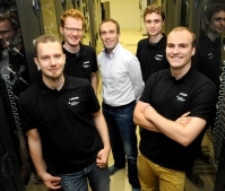Nov 20 2013
"When the wind blows over the ocean, waves form," Michael Bussmann, head of a HZDR junior research group, starts to explain. "At high wind speeds, water and wind swirl about one another, which is how spray and froth arise. Spray is thus a turbulent mixture of water and air. A similar thing occurs in space when a star ejects hot gas.
The jet created by the hot plasma mixes with other gas that surrounds the star. Turbulent flows arise at the boundary region between the two gases." The staff members of the "Computational Radiation Physics" group recently studied the formation of these turbulent phenomena, known as Kelvin-Helmholtz instabilities, with the help of simulations.

"We hope to understand Kelvin-Helmholtz instabilities in detail. To do so, we have tried something that almost no one else has up to now," explains Bussmann. "We have simulated a plasma jet at such high resolution that we could follow the electrons in the jet. That by itself requires enormous computing power, as we had to simulate almost a hundred billion particles." It is impossible even with the most modern telescopes to see individual particles in a stellar jet, however. Scientists were therefore faced with the problem of how to compare their theoretical results to observations. They solved it by making use of the fact that electrons emit light over a broad spectrum of wavelengths when they change their direction of motion or speed. They adapted their simulation program PIConGPU to allow light emitted in all directions to be calculated from the motion of the electrons.
"With luck, we are able to see the light emitted with telescopes from Earth," explains the physicist. "We can therefore simulate something that can be measured on earth. However, the computer power necessary for this is enormous." The light emitted had to be calculated individually for the billions of electrons in the simulation – and in hundreds of different directions. For this reason, the HZDR team used what was then the most powerful supercomputer in the world for their calculations in June of this year: TITAN at Oak Ridge National Laboratory. PIConGPU spent over 16 hours calculating the solution to this problem using 18,000 graphics cards. Few simulation programs can make use of such powerful compute capability. Simulations that operate the most efficiently are honored each year with the Gordon Bell Prize for outstanding achievement in the field of high-performance computing, for which the HZDR scientists have now been nominated.
"We will find out whether we have won at the Supercomputing Conference 2013 in Denver mid-November. It is already a real honor to be among the six finalists. I am very proud of what everyone has achieved. That was great teamwork!" emphasizes Bussmann. "We have obtained unique scientific data with the simulations run on TITAN. It is such a huge quantity that we are still busy evaluating it. Everyone on the team is very excited about what we will discover." Plasmas play a central role in research carried on by the Junior Research Group.
The HZDR researchers hope to understand the properties of laser-driven radiation sources more precisely with the help of analytical models and simulations. Compact accelerators for treating cancer with energetic particles could be developed with these radiation sources. The scientists want to use high-intensity laser pulses to achieve this goal. They thus have to precisely understand the interaction of the laser light with matter in order to optimize these advanced radiation sources for applications. For this they simulate this interaction on the atomistic level, the level of individual electrons and atoms.